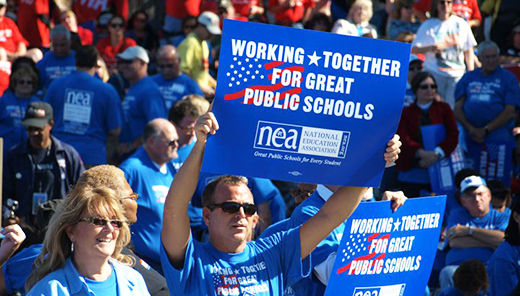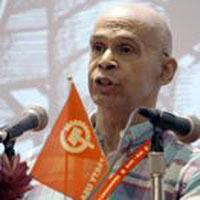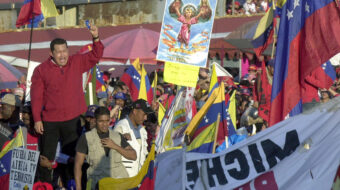
How do you judge a rally’s success? That question came to mind when reading press comparisons of the Oct. 2 One Nation Working Together rally to Glenn Beck’s Restoring Honor event.
How about the spirit of the participants?
When arriving in Washington D.C.’s Union Station a train full of passengers bound for the One Nation rally stood up, clapped and cheered.
“It’s time to fight for jobs” said one enthusiastic young woman who boarded at Philadelphia. True, their enthusiasm was tempered by anger and concern: anger not at the president, but at the inertia in Congress and the obstructionism of the GOP.
Another measure might be who was there.
Assembled on Oct. 2 were Asian, black, brown, Native American, white, gay and straight men and women decked out in red, blue and white T-shirts. They came from trade unions, universities, churches, mosques and synagogues, with signs defending the president, calling for jobs, for repeal of “don’t ask, don’t tell,” or “hands off Social Security.”
Still another gauge is the politics that came from the speakers’ platform.
On Oct. 2 it was decidedly anti-right-wing, anti-corporate, and pro-working class and pro-American-people. Two themes stood out: that the politics of the Republican right wing are against the national interest, and that the central task of the times is solve the jobs crisis.
“It’s about people standing up to the corporations,” boomed Ed Schultz, the MSNBC news commentator who was master of ceremonies for the program, which began with an interfaith prayer service and rendition of Kool & The Gang’s “Celebration” by the Urban League choir. “They don’t believe in freedom: they want a concentration of wealth,” Schultz continued.
Singling out the GOP Senate minority, Shultz said, “Forty people have held down working America.” Taking aim at the ruling corporations, the rally MC declared, “The other people want profit; they don’t care about the people.”
For many who lived and struggled through the recession of the early 1980s when the unemployment level was even higher than today, the broad acceptance of the centrality of the struggle for jobs was truly remarkable.
Even Marc Morial of the center-of-the-road Urban League spoke of the need for jobs to rebuild American cities. He said, “Too many people are hurting. Without good jobs to support our families, our nation cannot recover.” Morial called for creating 3 million new jobs.
Worker rights; peace; activism; electoral struggle; unity – all were highlighted in speech after speech. Jesse Jackson, addressing the crowd, said, ” We globalized capital without globalizing workers’ rights.” A former Iraq veteran, Bishop Garrison, said, “I went to Iraq on two separate deployments; for months I struggled to find work; soldiers found themselves left out in the cold.”
Garrison said “millions of dollars of debt” have been accumulated while the “working class continues to pay the bills.” Al Sharpton pointed to the need to focus on the midterm elections, “We have to get ready for midterm exams,” he exhorted the demonstrators.
Yet, much of the commentary on the march has centered on its size, comparing it to the Beck/Palin event on Aug. 28. Writers in the capitalist press, including the New York Times and Washington Post, claim the Fox-News-sponsored affair on the steps of the Lincoln Memorial in August was larger, suggesting a bigger base and greater momentum for the Republican right.
However, considering the platform and social base of both events, this is an odd comparison, a pairing of apples with rotten tomatoes. Seeking a large audience, Glenn Beck and Sarah Palin took a page from Louis Farrakhan’s Million Man March in 1995 and the earlier Promise Keepers and stayed away from controversial issues. Recall that the Farrakhan-initiated march was organized under the banner of atonement and, save for the speeches of Jesse Jackson and few others at that event, offered little response to the Newt-Gingrich-led assault on the safety net taking place a few blocks away.
No fools, Beck and Palin and their handlers were careful in both promotion and from the platform to stay away from issues and particularly mention of the November elections.
It was a clever tactic enabling them to draw a large and ideologically diverse crowd including GOP moderates, independents and centrists. After all who opposes honoring men and women in uniform? Given the extensive corporate sponsorship and the promotion given by Fox, the turnout was not a surprise.
One Nation on Oct. 2, rather than shying away from issues, took them head on. In doing so it helped break new political ground in what is proving to be an extraordinary moment. In this sense its large size and the diverse coalition that sponsored it was a huge success.
In recent memory no one has dared called for a rally and demonstration in an election year; these in fact are a “no, no,” among the professional organizing class.
Indeed, when the NAACP and 1199 issued the call last spring, one could almost hear the yelps of incredulity. Yet, the immigrant rights movement broke the winter ice of tradition on May Day with huge marches and protests across the country.
They were correct. In today’s world, convention is being thrown out the window and all traditional bets are off. Politics-as-usual is giving way to innovative and novel organizing tactics in the great class and democratic contests that will determine our country’s future. Of course the old tools should not be thrown away. In addition, moral and non-political themes should not be so easily ceded to the right.
A few years ago a movement was born. It is still young; its steps uncertain. Yet if the politics, composition, enthusiasm and fighting stance of the coalition assembled in Washington on Oct. 2 is any indication, it is well on its way.
Photo: National Education Association members at the Oct. 2 One Nation march. (Photo by John Gaudette)












Comments